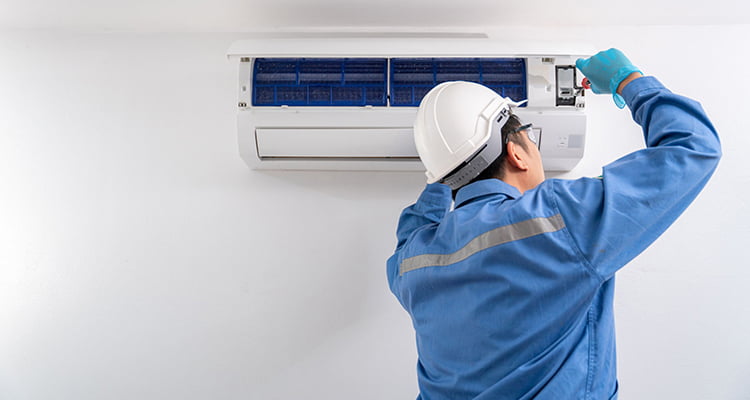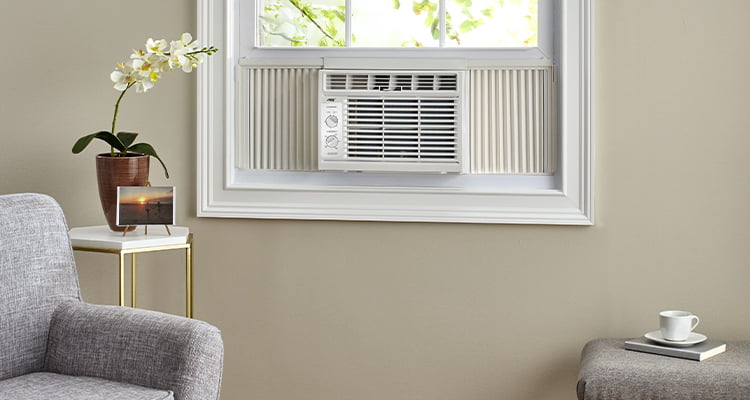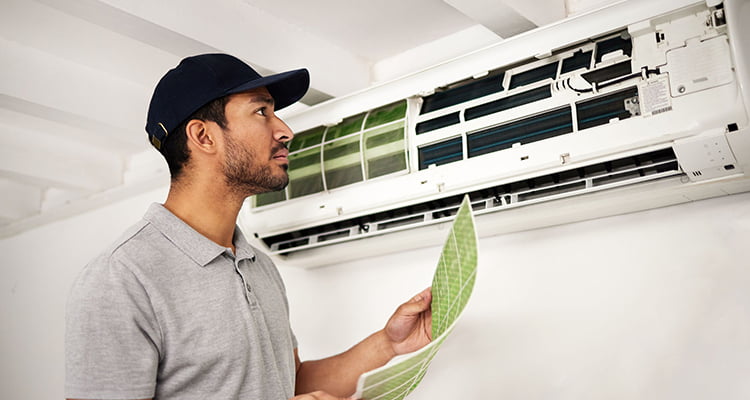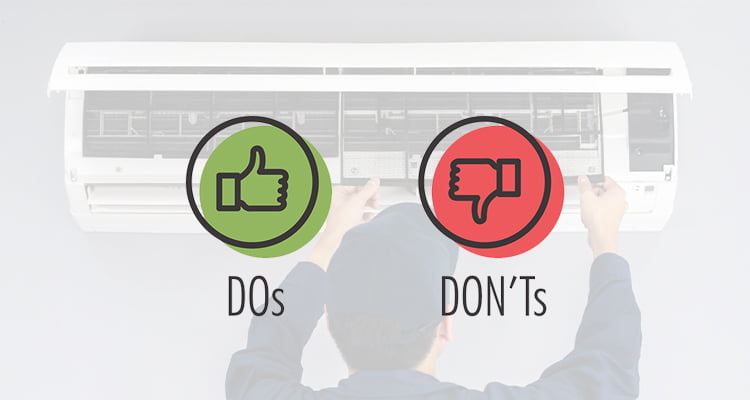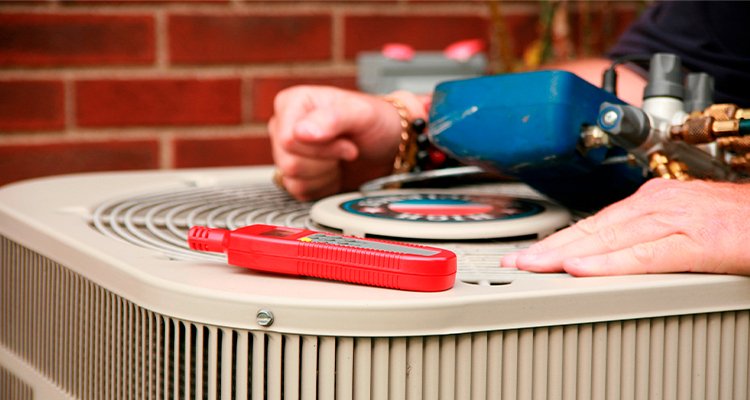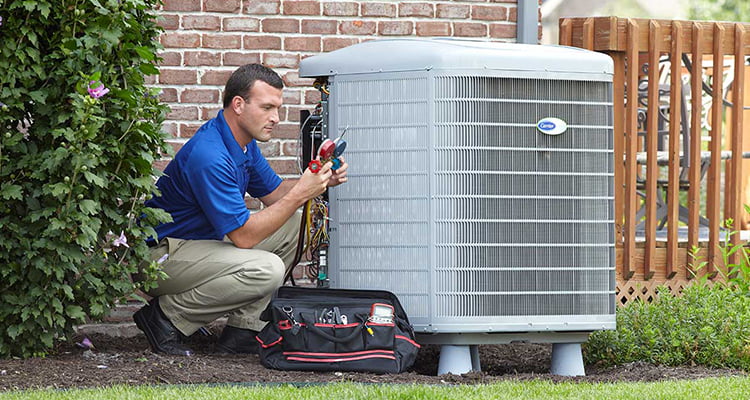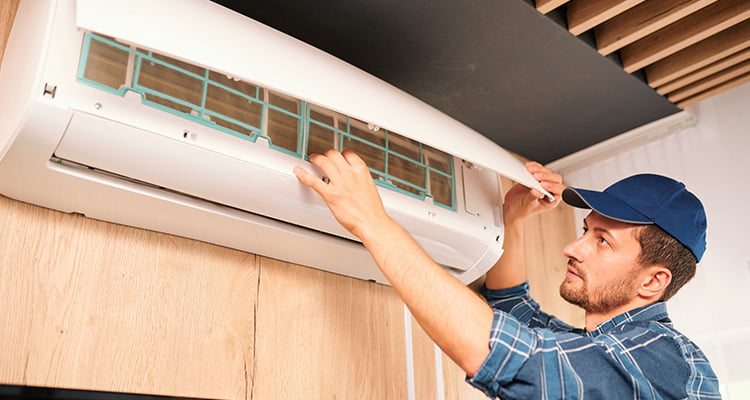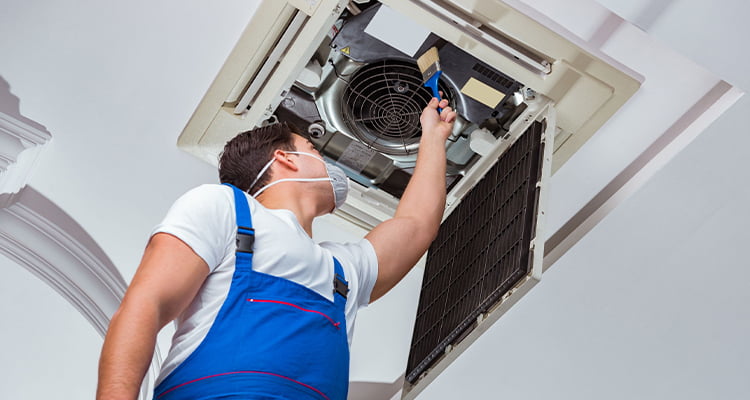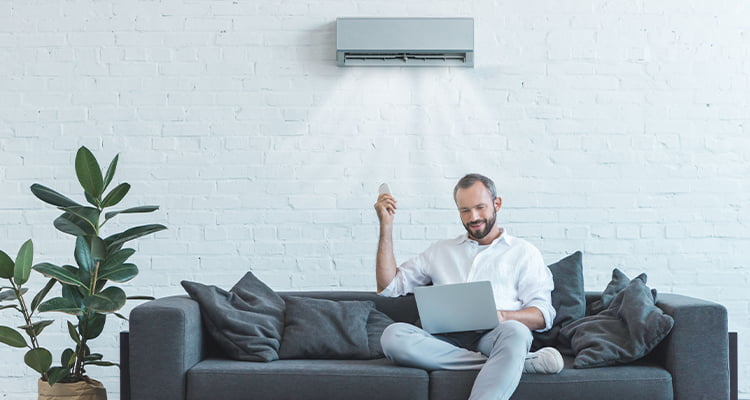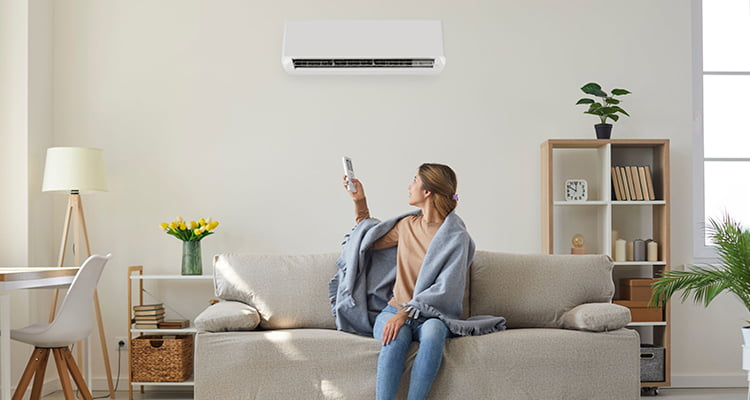Category: Air Conditioning
Are Window Mount Air Conditioners the Same as Wall Mounted?
Comparing Window Mount and Wall Mounted Air Conditioners: Key Differences
As the summer heat rolls in, homeowners look for efficient ways to cool their homes. And when it comes to cooling your home, selecting the right type of air conditioner is crucial for comfort and efficiency. Two popular options are window-mounted air conditioners and wall-mounted air conditioners. While they might seem similar at first glance, there are significant differences between the two in terms of installation, performance, and use cases. Understanding these differences can help you make an informed decision that suits your home and lifestyle. In this blog, we’ll compare window-mounted air conditioners and wall-mounted units to help you determine which is best for your needs.Window Mount Air Conditioners
Window-mount air conditioners are designed to fit into a window frame. They are typically installed by sliding the unit into an open window and securing it in place. This type of installation is relatively straightforward and doesn’t usually require professional assistance.Pros:
- Ease of Installation: Most window mount air conditioners can be installed by homeowners without professional help.
- Temporary Solution: Ideal for renters or those who need a temporary cooling solution.
Cons:
- Window Space Utilization: Occupies window space, which can limit natural light and ventilation.
- Security Concerns: This may pose a security risk if not properly secured.
Wall Mounted Air Conditioners
Wall-mounted air conditioners, on the other hand, require a hole to be cut into an exterior wall. This installation is more permanent and typically requires professional assistance to ensure it is done correctly and safely.Pros:
- Permanent Solution: Provides a long-term cooling solution without occupying window space.
- Aesthetic Appeal: Blends seamlessly into the wall, maintaining the room’s aesthetic.
Cons:
- Professional Installation Required: This usually requires professional installation, which can add to the initial cost.
- Structural Modifications: Involves cutting into the wall, which might not be feasible for all homes.
Performance
Window Mount Air Conditioners
Window-mount air conditioners are generally effective for cooling single rooms or small spaces. They are known for their straightforward operation and affordability.Pros:
- Affordability: Generally less expensive than wall-mounted units.
- Effectiveness: Efficient for cooling small to medium-sized rooms.
Cons:
- Noise Level: Can be noisier compared to wall-mounted units due to their compact design.
- Energy Efficiency: This may not be as energy-efficient as wall-mounted units, leading to higher energy bills.
Wall Mounted Air Conditioners
Wall-mounted air conditioners are often part of a split system, with the compressor located outside and the air handling unit inside. This setup allows for better performance and energy efficiency.Pros:
- Energy Efficiency: Typically more energy-efficient, leading to lower operating costs.
- Quiet Operation: Quieter than window units because the compressor is located outside.
Cons:
- Initial Cost: Higher upfront cost due to the need for professional installation and the price of the unit itself.
- Maintenance: May require more frequent maintenance to keep the system running efficiently.
Use Cases
Window Mount Air Conditioners
Window mount air conditioners are best suited for many different reasons, some of those include:- Renters: Ideal for renters who need a non-permanent cooling solution.
- Small Spaces: Perfect for cooling single rooms or small apartments.
- Temporary Needs: Useful for temporary cooling needs, such as during a heatwave.
Wall Mounted Air Conditioners
Wall-mounted air conditioners are ideal for some of the most useful reasons that include:- Homeowners: Suitable for homeowners looking for a permanent and efficient cooling solution.
- Larger Spaces: Effective for cooling larger areas or multiple rooms with the use of multiple units or a split system.
- Aesthetic Considerations: Those who want a sleek, unobtrusive air conditioning solution.
Choosing the Right Option
When deciding between a window mount air conditioner and a wall-mounted air conditioner, consider the following factors:-
Space and Layout:
- If window space is limited or you prefer not to obstruct your windows, a wall-mounted air conditioner may be the better option.
-
Budget:
- If you have a limited budget, a window-mount air conditioner is more affordable upfront. However, consider the long-term energy savings with a wall-mounted unit.
-
Installation:
- For ease of installation and portability, a window mount air conditioner is suitable. If you’re looking for a permanent solution, a wall-mounted unit is the way to go.
-
Aesthetic and Noise:
- Wall-mounted air conditioners offer a more aesthetically pleasing and quieter solution compared to window units.
How Pro West Heating And Air Conditioning Can Help You?
At Pro West Heating and Air Conditioning, we specialize in providing top-quality HVAC services, including air conditioning installation, maintenance, and repair. With years of experience and a team of skilled technicians, we are committed to ensuring your complete satisfaction and comfort. Contact us today to learn more about our services and how we can help keep your home cool and comfortable all year round.The Role Of Air Filters In Central Air Conditioner Performance And Repair
The air conditioning system is a complex unit of mechanical parts and electrical components that make the cooling and heating of our homes possible. Central air conditioners are essential for maintaining a comfortable indoor environment, especially during the hot summer months in the Lower Mainland of BC.
However, regular maintenance is key to keeping your system running efficiently, and one of the most critical components to maintain is the air filter. In this blog, we will discuss how air filters affect central air conditioner performance and the steps you can take to maintain them to avoid frequent repairs.
Filtering Contaminants
Air filters remove airborne particles like dust, pollen, pet dander, and other pollutants from the air circulated by the HVAC system. Designed to trap these contaminants, air filters prevent them from entering your home, thereby improving and maintaining indoor air quality.
Furthermore, this is particularly important for residents in the Lower Mainland cities like Coquitlam, Langley, and the Tri-Cities, where air quality can vary. Clean air filters ensure that the air you breathe is free from harmful contaminants, which is especially beneficial for individuals with allergies or respiratory conditions.
Protecting AC Components
Air filters also protect the various components of the HVAC system. Without a clean filter, outdoor particles and contaminants can land on the evaporator coils, blower fan, and motor, leading to poor efficiency and frequent breakdowns.
By filtering out these particles, air filters help maintain the optimal condition of your AC unit, reducing the need for central air conditioner repairs.
Maintaining Energy Efficiency
A clean air filter allows for proper airflow throughout the AC system. When the filter is dirty or clogged, it obstructs the airflow, forcing the AC system to work harder to circulate air. This increased workload leads to higher energy consumption, reduced cooling capacity, and potential overheating of the system.
By regularly replacing or cleaning the air filter, you can help maintain optimal energy efficiency, reducing your energy bills and the environmental impact of your HVAC system.
Extending The System’s Lifespan
Due to the protection air filters provide, they help the AC maintain its optimal condition and energy efficiency levels. This means you won’t need to replace the unit prematurely or deal with frequent repairs. Good air filters contribute to a longer lifespan for your air conditioning system, saving you money and reducing the inconvenience of unexpected breakdowns.
How To Maintain Your Air Filters
1. Regular Inspections
Inspecting your air filters regularly is essential, especially during peak usage periods. For most homes in the Lower Mainland, this means checking the filters at least once a month during the summer and winter months when the HVAC system is used more frequently.
Regular inspections help you identify when the filter needs to be replaced or cleaned.
2. Replacing Disposable Filters
If your central air conditioner uses disposable filters, it’s crucial to replace them according to the manufacturer’s recommendations. Generally, disposable filters should be replaced every 1-3 months.
However, if you have pets, live in a dusty area, or have family members with allergies, you may need to replace them more frequently. Always use the correct size and type of filter specified by your HVAC system’s manufacturer to ensure proper fit and function.
3. Cleaning Reusable Filters
Regular cleaning is necessary for systems with reusable filters to maintain their effectiveness. Follow these steps to clean your reusable air filter:
- Turn Off the HVAC System: Ensure the system is turned off to prevent any debris from being sucked into the unit during cleaning.
- Remove the Filter: Carefully remove the filter from its housing, taking note of how it fits to ensure proper reinstallation.
- Vacuum the Filter: Use a vacuum cleaner with a soft brush attachment to remove loose dust and debris from the filter.
- Wash the Filter: Rinse the filter with lukewarm water, using a mild detergent if necessary. Avoid using high-pressure water, as it can damage the filter material.
- Dry the Filter: Allow the filter to air dry completely before reinstalling it. Ensure it is thoroughly dry to prevent mould growth.
4. Checking For Damage
During inspections and cleaning, check the filter for any signs of damage, such as tears or holes. A damaged filter cannot effectively trap particles and should be replaced immediately to ensure your central air conditioner operates efficiently.
Specific Impact Of Air Filters On Central Air Conditioner Repair
Preventing Common Issues
A clean air filter can help prevent several common issues that require central air conditioner repair. These include:
- Frozen Evaporator Coils: A dirty filter restricts airflow, causing the evaporator coils to freeze. This can reduce cooling efficiency and potentially damage the compressor.
- Overheating: Restricted airflow forces the blower motor to work harder, which can cause it to overheat and fail prematurely.
- Poor Airflow: A clogged filter reduces the system’s ability to circulate air effectively, leading to uneven cooling and increased wear on the system.
Reducing Repair Frequency
By maintaining clean air filters, you can reduce the frequency of central air conditioner repairs. Clean filters ensure that your system operates efficiently and effectively, reducing the likelihood of breakdowns and the need for emergency repairs. This not only saves you money on repair costs but also extends the lifespan of your HVAC system.
Cost Savings
Regular maintenance, including keeping your air filters clean, can lead to significant cost savings over time. Efficient operation reduces energy consumption, lowering your utility bills. Additionally, by preventing common issues and reducing the need for repairs, you save on service costs and extend the life of your central air conditioner.
How Pro West Heating And Air Conditioning Can Help You?
At Pro West Heating and Air Conditioning, we specialize in providing top-quality HVAC services, including air conditioning installation, maintenance, and repair. With years of experience and a team of skilled technicians, we are committed to ensuring your complete satisfaction and comfort.
Contact us today to learn more about our services and how we can help keep your home cool and comfortable all year round.
AC Installation Dos And Don’ts: What You Need To Know
A reliable air conditioning system is a must-have for keeping your home cool and comfortable during the scorching summer months. However, installing an AC unit is not as simple as it may seem. Whether you’re upgrading your existing system or installing a new one, it’s crucial to get it right the first time.
That’s where HVAC contractors come in – they are the experts who ensure that your AC installation is done correctly and efficiently.
Why You Need Professional Help
Installing an air conditioning system involves more than just setting up the unit and turning it on. It requires careful planning, precise measurements, and technical expertise.
Without proper installation, you may encounter a host of problems down the line, such as inefficient cooling, frequent breakdowns, and higher energy bills.
The Dos Of AC Installation
1. Do Proper Sizing
One of the most critical aspects of AC installation is ensuring that the unit is properly sized for your home. An HVAC contractor will thoroughly assess your home’s size, layout, insulation, and other factors to determine the right size unit for optimal performance.
Oversized units can lead to short cycling and increased energy consumption, while undersized units may struggle to cool your home effectively.
2. Do Consider Energy Efficiency
Opt for an energy-efficient air conditioning system that not only keeps your home cool but also helps reduce your energy consumption and utility bills. Look for units with a high SEER (Seasonal Energy Efficiency Ratio) rating.
Additionally, consider features such as programmable thermostats, variable-speed air handlers, and zoning systems to further enhance energy efficiency and comfort.
3. Do Ensure Proper Airflow
Proper airflow is essential for efficient cooling and even air distribution throughout your home. Your HVAC contractor will ensure that the ductwork is correctly sized and installed to maximize airflow and minimize energy loss.
They will also assess duct design, insulation, and sealing factors to optimize system performance.
4. Do Invest In Professional Installation
While DIY installation may seem tempting to save money, it can lead to costly mistakes and potential safety hazards. Hiring a qualified HVAC contractor ensures that the installation is done correctly and up to code, giving you peace of mind and reliable cooling for years to come.
Professional installers have the knowledge, experience, and tools to handle complex installation tasks safely and efficiently, minimizing the risk of errors and ensuring a seamless installation process.
Also Read: Key Factors Affecting The Cost Of Central Air Conditioner Installation
The Don’ts Of AC Installation
1. Don’t Neglect Maintenance
Once your AC system is installed, regular maintenance is key to keeping it running smoothly. Neglecting maintenance tasks such as filter changes, coil cleaning, and system inspections can lead to decreased efficiency and premature system failure.
Schedule annual maintenance visits with your HVAC contractor to ensure that your system remains in optimal condition and continues to operate efficiently.
2. Don’t Skip Professional Help
Even if you’re handy around the house, professional AC installation is the best course of action. Attempting DIY installation can void warranties, compromise system performance, and pose safety risks.
Professional installers have the necessary training, expertise, and equipment to ensure that your AC system is installed correctly and operates safely and efficiently.
They will also handle any necessary permits and inspections to ensure compliance with local building codes and regulations.
3. Don’t Overlook Proper Insulation
Proper insulation is essential for maintaining a comfortable indoor temperature and reducing energy waste. Your HVAC contractor will assess your home’s insulation needs and recommend upgrades as necessary to improve energy efficiency.
This may include adding insulation to walls, floors, and attics, sealing air leaks, and installing weatherstripping around doors and windows.
Proper insulation helps prevent heat transfer and keeps conditioned air inside your home, reducing the workload on your AC system and lowering energy costs.
4. Don’t Forget About Ventilation
Adequate ventilation is crucial for removing stale air, controlling humidity levels, and ensuring indoor air quality. Your HVAC contractor will assess your home’s ventilation requirements and recommend solutions to promote healthy indoor air.
This may include installing exhaust fans in bathrooms and kitchens, upgrading your ventilation system to improve airflow, and ensuring proper ventilation in attics and crawl spaces.
Proper ventilation helps prevent moisture buildup, mould growth, and indoor air pollutants, creating a healthier and more comfortable living environment.
About Pro West Heating And Air Conditioning
At Pro West Heating and Air Conditioning, we specialize in providing top-quality HVAC services, including air conditioning installation, maintenance, and repair. With years of experience and a team of skilled technicians, we are committed to ensuring your complete satisfaction and comfort.
Contact us today to learn more about our services and how we can help keep your home cool and comfortable all year round.
Extending The Lifespan Of Your Central Air Conditioner With Professional Repairs
Most people will strongly agree that having an air conditioning system inside the home is an incredible convenience that is hard to live without. Many will also agree that replacing an air conditioner is one of the most expensive upgrades in the home.
Professional central air conditioner repair and regular maintenance are key factors in extending the lifespan of your unit. Ensuring that your central air conditioning unit operates efficiently and lasts for many years requires regular maintenance and timely repairs.
Thus, extending your Air Conditioner’s lifespan is a high priority for those who want to avoid paying high AC replacement costs. As one of the top experts in repairing air conditioners, we have compiled a list of tips for extending your AC’s lifespan below.
The Importance Of Regular Maintenance
Preventative Maintenance
Preventative maintenance involves routine inspections and minor repairs that keep your central air conditioner running smoothly. By addressing potential small issues at the right time before they become major problems, preventative maintenance can help avoid costly repairs and system breakdowns.
This proactive approach ensures that all components of your air conditioner are functioning correctly, and are in good working condition, thereby extending the unit’s lifespan.
Components That Require Regular Attention
Several key components of your central air conditioner require regular maintenance to ensure optimal performance:
- Air Filters: Dirty or clogged filters restrict airflow, forcing the system to work harder potentially leading to overheating. Regularly replacing or cleaning air filters can improve efficiency and longevity.
- Coils: Both the evaporator and condenser coils collect dirt over time, which can reduce their ability to absorb and release heat. Cleaning these coils ensures efficient heat exchange.
- Fins: The aluminum fins on coils can bend and block airflow. Professionals can straighten these fins to maintain proper airflow.
- Condensate Drains: Clogged drain channels can cause excess moisture and increase humidity levels in your home. Keeping these drains clear prevents moisture-related issues.
Also Read: Overcoming The Challenges Of Installing Central Air In An Older Home
Common Issues That Require Professional Repair
Refrigerant Leaks
Low refrigerant levels can impact your air conditioner’s ability to cool your home effectively. When your system is low on refrigerant, it struggles to reach the desired temperature, leading to inadequate cooling.
This means your air conditioner has to work harder, which reduces its efficiency and increases your energy bills. You end up paying more for less comfort.
Professional technicians can accurately locate and repair refrigerant leaks. Using specialized tools, they can identify the exact location of the leak and fix it, ensuring that your system maintains the correct refrigerant level for optimal performance.
By addressing refrigerant leaks timely, you can keep your air conditioner running smoothly and efficiently, prolonging its lifespan and saving money on energy costs.
Electrical Issues
Electrical problems, such as faulty wiring, short circuits, or issues with the thermostat, can cause your air conditioner to malfunction or stop working altogether. These problems can be dangerous and damage your air conditioner’s internal components, making it more difficult and expensive to repair.
For example, faulty wiring can lead to power surges that damage the compressor or fan motor. Short circuits can cause the system to shut down unexpectedly, and a malfunctioning thermostat might not signal the air conditioner to turn on or off at the right times.
Professional technicians are trained to handle electrical repairs safely, ensuring that your system operates reliably and safely. They can diagnose electrical issues, replace damaged wires, and ensure all connections are secure, preventing further damage and enhancing the longevity of your air conditioner.
Mechanical Wear And Tear
Over time, the mechanical components of your air conditioner, such as the compressor, swings, and fan motors, can experience wear and tear. These parts are essential for the operation of your air conditioner, and if they become worn out or damaged, your system may not function properly.
Regular maintenance and timely repairs by professionals can address these issues before they lead to major breakdowns. Technicians can inspect and lubricate moving parts, replace worn-out components, and ensure that all mechanical parts are in good working condition.
By addressing mechanical wear and tear early, you can prevent sudden failures, reduce repair costs, and extend the lifespan of your air conditioning unit.
Airflow Problems
Restricted or poor airflow is one of the major reasons that your air conditioner can be put under strain, reducing its efficiency and lifespan. When airflow is restricted, the system has to work harder to push cool air through the ducts and into your living spaces. This extra effort can cause the components to wear out faster, leading to overheating and system breakdowns.
Blocked ducts, dirty air filters, and malfunctioning fans are common causes of airflow problems. Professional technicians can identify and fix these issues, ensuring that your system operates at peak performance.
They can clean or replace dirty filters, clear blockages in the ducts, and repair or replace malfunctioning fans. By improving airflow, you enhance the efficiency of your air conditioner, reduce energy consumption, and extend its operational life.
How Pro West Heating And Air Conditioning Can help you?
Pro West Heating and Air Conditioning specializes in providing top-quality HVAC services, including air conditioning installation, maintenance, and repair. With years of experience and a team of skilled technicians, we are committed to ensuring your complete satisfaction and comfort.
Contact us today to learn more about our services and how we can help keep your home cool and comfortable all year round.
The Central Air Conditioner Installation Process
There’s nothing quite like walking into a cool, air-conditioned home after being out in the summer heat. If you’re considering a central air conditioner to keep your house comfortable, you’re making a wise choice.
Unlike portable or window units, this system provides consistent cooling throughout your entire home. But what exactly does the installation process entail? Hear from an HVAC expert. From evaluating your home’s needs to the final testing phase, this comprehensive guide will walk you through each step.
By understanding the process, you can ensure a smooth installation and enjoy the benefits of a comfortable, cool home all summer long.
Preparing For Central Air Conditioner Installation
Before installing a central air conditioner, you must assess your home’s cooling needs. How large is your home? What kind of insulation does it have? These factors will help determine the size and type of system you need. It’s also essential to consider the climate in your area.
An efficient system is crucial for Canadian homes where summers can get quite hot.
Selecting the right central air conditioner is vital. You need a system that is the right size for your home. If it’s too small, it won’t cool your home effectively. If it’s too large, it will cycle on and off too frequently, leading to increased wear and tear.
Installing a central air conditioner can be a significant investment. It’s essential to budget not just for the unit itself but also for installation costs. The installation process involves several steps, including ductwork, electrical work, and potentially upgrading your home’s insulation. Make sure to get a detailed estimate from your HVAC contractor.
The Installation Process
Step 1: Evaluating Your Home
The first step in the installation process is thoroughly evaluating your home. The HVAC technician will inspect your existing heating and cooling system, assess your ductwork, and determine the best location for the new unit.
This evaluation ensures that the installation process goes smoothly and that the new system will operate efficiently.
Step 2: Removing The Old System
If you have an existing air conditioning system, it must be removed. This process includes safely disconnecting and disposing of the old unit. Proper disposal is crucial to ensure environmental safety and compliance with local regulations.
Step 3: Installing The New Unit
Once the old system is removed, the new central air conditioner can be installed. This step involves several components:
- Mounting the Indoor Unit: The indoor unit, also known as the evaporator coil, is typically installed near your furnace or air handler. This unit will connect to your existing ductwork to distribute cool air throughout your home.
- Installing the Outdoor Unit: The outdoor unit, or condenser, is placed outside your home. To maximize efficiency, it should be located in a shaded area. The technician will ensure it is level and has proper clearance for airflow.
- Connecting the Units: The indoor and outdoor units are connected by refrigerant lines, electrical wiring, and a drain line. These connections are critical for the system’s operation and must be done correctly to avoid leaks or malfunctions.
Step 4: Connecting The Ductwork
If your home already has ductwork, it may need to be inspected and potentially upgraded to ensure compatibility with the new system. In some cases, new ductwork may need to be installed. Proper ductwork is essential for distributing cool air evenly throughout your home.
Step 5: Electrical And Thermostat Installation
The next step involves connecting the central air conditioner to your home’s electrical system. This process should always be done by a licensed electrician to ensure safety and compliance with local codes.
Additionally, a new thermostat may be installed to provide better control over your home’s temperature.
Step 6: Testing The System
After the installation, the HVAC technician will test the system to ensure it works correctly. This testing includes checking the refrigerant levels, ensuring adequate airflow, and verifying that the thermostat is functioning properly. The technician will also show you how to operate and maintain your new system.
Post-Installation Considerations
Regular maintenance is crucial to keeping your central air conditioner running smoothly. This maintenance includes changing the air filter, cleaning the coils, and scheduling annual check-ups with a professional HVAC technician. Regular maintenance helps prevent breakdowns and extends the life of your system.
Even with proper maintenance, your central air conditioner may encounter issues. Common problems include inadequate cooling, unusual noises, and high energy bills. If you experience any of these issues, it’s essential to contact a professional for diagnosis and repair.
To get the most out of your central air conditioner, consider adding additional upgrades to your home. Improving insulation, sealing windows and doors, and using a programmable thermostat can all help maximize your system’s efficiency.
These upgrades can also reduce energy bills and improve your home’s comfort.
About Us
At Pro West Heating & Air Conditioning, we are dedicated to providing top-quality HVAC services to our clients. With years of experience and a commitment to excellence, we ensure your home stays comfortable year-round.
Contact us today to learn more about our services and how we can help with your heating and cooling needs.
How To Prepare Your AC For Extreme Weather
Get Your AC Ready for Extreme Weather with These Tips
As the seasons change and the weather becomes more unpredictable, it’s essential to ensure your air conditioner is ready to handle extreme conditions. Proper air conditioner maintenance not only improves efficiency but also extends the lifespan of your unit. Whether it’s the sweltering heat of summer or unexpected heat waves, a well-maintained AC system can keep your home comfortable and safe. In this blog post, we will guide you through the crucial steps to prepare your AC for extreme weather, ensuring optimal performance when you need it most with the help of experienced HVAC contractors.The Importance Of Air Conditioner Maintenance
Before diving into the specifics, let’s discuss why air conditioner maintenance is crucial. Regular maintenance helps in:- Improving Efficiency: A well-maintained AC runs more efficiently, reducing energy consumption and lowering your utility bills.
- Extending Lifespan: Proper care can extend the life of your air conditioner, saving you from premature replacements.
- Enhancing Air Quality: Clean filters and components contribute to better indoor air quality, which is essential for your family’s health.
- Preventing Breakdowns: Routine checks can identify and fix minor issues before they become major problems, avoiding costly repairs during peak seasons.
Step-By-Step Guide To Preparing Your AC For Extreme Weather
1. Inspect And Clean The Filters
One of the most critical aspects of air conditioner maintenance is keeping the filters clean. Dirty filters can obstruct airflow, making your unit work harder and less efficiently. Here’s how you can handle this:- Monthly Check: Inspect the filters at least once a month. During extreme weather periods, consider checking them more frequently.
- Cleaning Or Replacement: Depending on your filter type, either clean or replace them. Disposable filters should be replaced, while reusable filters can be cleaned with water and a mild detergent.
2. Check And Clean The Coils
Both the evaporator and condenser coils are crucial for your AC’s performance. Over time, these coils collect dirt, which reduces their efficiency.- Annual Cleaning: Clean the coils at least once a year. This process can be complex, so consulting with a professional HVAC contractor is advisable.
- Clearing Debris: Ensure there’s no debris around the outdoor condenser unit. Leaves, grass, and dirt can obstruct airflow and reduce efficiency.
3. Inspect The Thermostat
Your thermostat plays a significant role in maintaining the desired temperature. Ensuring it functions correctly is vital for extreme weather preparedness.- Calibration Check: Verify that the thermostat is calibrated correctly. An incorrect calibration can lead to inefficient cooling.
- Upgrade To Programmable Thermostat: If you haven’t already, consider upgrading to a programmable thermostat. This allows you to set temperature schedules, improving efficiency and comfort.
4. Examine The Ductwork
Leaky or poorly insulated ducts can lead to significant energy loss, making your AC work harder and less effectively.- Visual Inspection: Check for visible signs of leaks or damage in the ductwork. Look for disconnected joints or holes.
- Professional Assessment: For a thorough inspection, it’s best to hire an HVAC contractor. They can use specialized equipment to detect and seal leaks, ensuring optimal airflow.
5. Test The System
Before extreme weather hits, it’s crucial to test your AC system to ensure it’s operating correctly.- Run A Full Cycle: Turn on the system and let it run through a full cooling cycle. Listen for unusual noises and check if the air coming out is cold.
- Monitor Performance: Pay attention to how long it takes to reach the desired temperature and whether it maintains that temperature consistently.
6. Schedule A Professional Maintenance Visit
While DIY maintenance is essential, nothing beats a comprehensive check-up by a professional. A certified HVAC technician can perform tasks that might be beyond the scope of a homeowner, such as:- Refrigerant Level Check: Ensuring the refrigerant levels are correct is crucial for efficient cooling.
- Electrical Component Inspection: A technician can inspect and tighten electrical connections, which is vital for preventing potential failures.
- Component Lubrication: Proper lubrication of moving parts reduces friction and wear, enhancing efficiency.
Preparing For Specific Extreme Weather Conditions
Heatwaves
During heatwaves, your AC system will be working overtime. To prepare for this:- Pre-Cool Your Home: Set your thermostat a few degrees lower before the heatwave hits. This gives your system a head start.
- Use Ceiling Fans: Complement your AC with ceiling fans to improve air circulation and reduce the load on your system.
- Close Blinds And Curtains: Keep your home cooler by blocking out direct sunlight.
Thunderstorms And High Winds
Storms can pose a risk to your outdoor unit. Here’s how to protect it:- Secure The Unit: Ensure the outdoor unit is securely mounted. High winds can damage a loose unit.
- Install A Surge Protector: Thunderstorms can cause power surges that damage your AC. A surge protector can prevent this.
About Pro West Heating And Air Conditioning
At Pro West Heating and Air Conditioning, we pride ourselves on providing top-notch HVAC services to keep your home comfortable throughout the year. With years of experience and a team of certified technicians, we offer comprehensive maintenance, repair, and installation services tailored to meet your specific needs. Whether you’re preparing your air conditioner for extreme weather or need emergency repairs, we’re here to help. Trust us to keep your HVAC system running smoothly, efficiently, and reliably. Contact us today for more information.The Impact Of Air Duct Cleaning On Central Air Conditioning Efficiency
How Air Duct Cleaning Improves Central Air Conditioning Efficiency
Ensuring our central air conditioning system runs efficiently is crucial for maintaining comfort and reducing energy costs. One essential maintenance task that often goes overlooked is air duct cleaning. Getting help from a professional HVAC contractor for this task is necessary to reap the full benefits. In this blog post, we’ll explore how air duct cleaning impacts the efficiency of central air conditioning systems and why regular maintenance by experienced HVAC contractors is key to optimizing performance.What Are Air Ducts?
Air ducts are the pathways that distribute cooled air from the air conditioner throughout our homes. They play a vital role in the overall performance of our HVAC system. Over time, these ducts can accumulate dust, dirt, and other contaminants, which can significantly impede airflow and reduce efficiency.The Impact Of Dirty Air Ducts
When air ducts are dirty, the HVAC system has to work harder to push air through the ducts. This increased workload not only decreases the efficiency of the system but also leads to higher energy consumption and costs. Additionally, dirty air ducts can compromise indoor air quality, potentially causing health issues for occupants.The Benefits Of Air Duct Cleaning
Improved Airflow
One of the most immediate benefits of air duct cleaning is improved airflow. Clean ducts allow air to move more freely, which means our air conditioning system doesn’t have to work as hard to maintain the desired temperature. This improved efficiency can lead to a noticeable reduction in energy bills.Enhanced Indoor Air Quality
Regular air duct cleaning helps remove contaminants such as dust, pollen, mould spores, and pet dander from our ducts. This results in cleaner air circulating throughout our home, which can be particularly beneficial for individuals with allergies or respiratory conditions.Extended HVAC System Lifespan
A well-maintained HVAC system is likely to have a longer lifespan. Regular duct cleaning can reduce the strain on our air conditioner, prevent potential breakdowns, and extend the life of the system, saving us from costly repairs or replacements down the line.The Process Of Air Duct Cleaning
Inspection And Assessment
The first step in air duct cleaning is a thorough inspection and assessment by an HVAC contractor. They will evaluate the condition of our ducts, identify any problem areas, and determine the best approach for cleaning.Cleaning Techniques
Professional HVAC contractors use specialized equipment to clean air ducts. This often involves high-powered vacuums and brushes designed to dislodge and remove debris from the ducts. In some cases, contractors may also use sanitizing agents to kill any mould or bacteria present in the ducts.Post-Cleaning Inspection
After the cleaning process, a reputable HVAC contractor will perform a post-cleaning inspection to ensure that all contaminants have been removed and that the ducts are in good condition. This step is crucial for verifying the effectiveness of the cleaning and ensuring that our system will operate efficiently.How Often Should Air Ducts Be Cleaned?
Factors Influencing Cleaning Frequency
The frequency of air duct cleaning can vary based on several factors, including the presence of pets, recent renovations, and overall air quality. As a general rule, it’s recommended to have our air ducts cleaned every 3 to 5 years. However, if we notice signs of excessive dust buildup or experience unexplained respiratory issues, it may be wise to schedule a cleaning sooner.Signs That Indicate It’s Time For Cleaning
- Visible dust and debris around vent openings
- Unusual odours when the HVAC system is running
- Increased allergy or asthma symptoms
- Inconsistent airflow or difficulty maintaining the desired temperature
What To Look For In An HVAC Contractor
When selecting an HVAC contractor for air duct cleaning, it’s important to consider the following:- Experience And Reputation: Look for contractors with a proven track record and positive customer reviews.
- Certifications And Training: Ensure the contractor is certified by recognized industry organizations and has received proper training.
- Comprehensive Services: Choose a contractor that offers a range of HVAC services, including inspections, maintenance, and repairs.
The Connection Between Air Duct Cleaning And Energy Savings
Reduced Energy Consumption
One of the most significant benefits of air duct cleaning is the potential for energy savings. By improving airflow and reducing the workload on our HVAC system, clean ducts can lead to lower energy consumption. This not only helps us save money on utility bills but also reduces our environmental impact.Increased System Efficiency
An efficient HVAC system operates more smoothly and effectively, providing consistent comfort throughout our home. Regular air duct cleaning helps maintain this efficiency, ensuring that our system can keep up with our cooling needs, especially during the hot summer months.Lower Maintenance Costs
By reducing the strain on our HVAC system, air duct cleaning can also help lower maintenance costs. Fewer breakdowns and repairs mean we can enjoy a more reliable system and avoid the inconvenience and expense of unexpected issues.About Pro West Heating And Air Conditioning
At Pro West Heating and Air Conditioning, we are dedicated to providing top-notch HVAC services to ensure the comfort and well-being of our customers. With years of experience in the industry, our team of certified professionals is equipped to handle all your HVAC needs, from air duct cleaning to system installations and repairs. We pride ourselves on delivering exceptional service and ensuring customer satisfaction with every job we undertake. Contact us today to learn more about our services and how we can help improve the efficiency and performance of your central air conditioning system.Cool Hacks For Small Spaces: Maximizing The Impact Of Wall-Mountable ACs
On a sweltering summer afternoon, you finally find yourself home after a long day. But as you step inside, your small apartment feels cramped and cluttered, with the bulky AC unit occupying precious floor space. The cooling is not up to par, and the comfort is missing.
Feels frustrating, right? We don’t want it to happen to you. That’s why, as an HVAC professional, we recommend getting wall-mounted ACs for small and compact spaces. Let’s learn some cool hacks and see how these AC units can add comfort to your home.
Why Choose Wall-Mounted AC For Small Spaces?
Tired of bulky, space-consuming AC units? Wall-mounted ACs solve this problem. They fit perfectly well on the wall and allow better air circulation, ensuring that cool air reaches every corner of your room. Now, you can use the remaining space more cleverly without making a mess.
Additionally, wall-mounted AC units blend seamlessly with your decor. Modern designs are sleek and unobtrusive, often coming in neutral colours that match any interior. This means you can keep your space cool without compromising on style.
Tips For Maximizing Wall-Mounted AC Efficiency
Optimal Placement
Where you install your wall-mounted AC matters! Placing it high on the wall ensures cool air circulates evenly. But what’s the best spot? Aim for the centre of the longest wall to keep every corner comfortably cool.
Regular Maintenance
Just like any appliance, your wall-mounted AC needs TLC. Regular cleaning and annual servicing keep it running smoothly. Remember, a happy AC means a happy home!
Utilize Programmable Settings
Did you know your wall-mounted AC can be a mind-reader? Well, almost! With programmable settings, you can set it to cool your space exactly when you need it. Talk about convenience!
Optimize Airflow
Want to supercharge your AC’s performance? Optimize airflow! Keep furniture and curtains away from the unit to ensure unrestricted airflow. This simple hack can make a big difference in cooling efficiency.
Monitor Temperature Settings
Are you guilty of cranking up the AC unnecessarily? Keep an eye on the temperature settings and avoid overcooling. Setting the thermostat a few degrees higher can save energy without sacrificing comfort.
Enhancing Air Quality
Many wall-mounted ACs have built-in air purifiers that improve indoor air quality. These filters capture dust, pollen, and other allergens, making your home healthier.
For those with respiratory issues or allergies, this feature is invaluable. Regularly clean or replace the filters to maintain their effectiveness.
Personalized Comfort Settings
Modern wall-mounted ACs come with customizable comfort settings. Use these features to create your ideal indoor environment. Set the temperature, fan speed, and air direction to suit your preferences.
Some units even have sleep modes that adjust the temperature gradually, ensuring a comfortable night’s sleep.
Maintaining A Wall-Mounted AC
Routine Cleaning
Routine cleaning is essential for the efficient operation of your wall-mounted AC. Dust and debris can accumulate on the filters and internal components, obstructing airflow and reducing efficiency.
Clean the filters monthly and wipe down the exterior with a damp cloth. For deeper cleaning, follow the manufacturer’s guidelines or seek professional help.
Seasonal Checks
Conduct seasonal checks before summer and winter. Inspect the unit for any signs of wear or damage. Clean the filters and check the drainage system to prevent leaks. If the unit has a dehumidifier, empty the water reservoir regularly.
These checks ensure your AC is ready to handle the seasonal demands.
Check For Leaks
Leaks can compromise the performance and efficiency of your wall-mounted AC. Regularly inspect the unit for any signs of water leakage, such as puddles or moisture accumulation around the base.
Leaks may indicate issues with the drainage system, such as clogged or disconnected drain pipes. If you notice any leaks, address them promptly to prevent water damage to your walls and floors.
Inspect Insulation
Proper insulation around your wall-mounted AC is essential for maximizing efficiency and reducing energy waste. Inspect the insulation around the unit to ensure it is intact and in good condition.
Look for any signs of wear or damage, such as tears or compression. Damaged insulation can allow cool air to escape, forcing your AC to work harder to maintain the desired temperature.
Professional Servicing
Even with regular maintenance, professional servicing is crucial. Technicians can identify and fix issues that may not be visible to the untrained eye. Schedule annual servicing to keep your wall-mounted AC in top condition.
This not only extends its lifespan but also maintains energy efficiency, saving you money in the long run.
About Us
At Pro West Heating & Air, we specialize in providing top-notch heating and cooling solutions tailored to your needs. With years of experience and a commitment to excellence, we ensure your home remains comfortable year-round. For more information, visit our website or contact us today.
Different Sizes And Capacities Of Wall-Mountable ACs
Finding the perfect air conditioner can be challenging, especially with the wide array of options available. For those looking to stay cool during the hot Canadian summers, wall-mountable ACs offer an excellent solution. These units are designed to be both functional and stylish.
But do you know about their different sizes and capabilities? Whether you’re outfitting a small bedroom, a medium-sized living room, or a large open-plan area, choosing the right size and capacity is essential for optimal comfort and energy savings.
As a reliable HVAC company, we are here to help you out. Let’s discover how you can choose the right-sized AC for your home.
Understanding AC Capacity: BTUs And What They Mean
The cooling capacity of an air conditioner is measured in British Thermal Units (BTUs). Simply put, the higher the BTU rating, the more cooling power the unit has. Here’s a breakdown of what different BTU ratings mean for wall-mountable ACs:
- 5,000-8,000 BTUs: Suitable for small rooms up to 350 square feet, like bedrooms or home offices.
- 9,000-12,000 BTUs: Ideal for medium-sized rooms between 350-550 square feet, such as living rooms or large bedrooms.
- 13,000-18,000 BTUs: Perfect for larger rooms or open-plan areas ranging from 550-1,000 square feet.
- 19,000 BTUs and above: Best for extra-large spaces, including large living areas, commercial spaces, or entire floors.
When choosing a wall-mountable AC, it’s crucial to match the BTU rating with the size of the room to ensure optimal cooling and energy efficiency.
Small Rooms: Best Wall-Mountable ACs Under 10,000 BTUs
For small rooms, you don’t need a high-capacity unit. An AC with a BTU rating between 5,000 and 8,000 will suffice. These units are compact and cost-effective, providing sufficient cooling for bedrooms, home offices, or small living spaces.
Benefits Of Lower BTU Wall-Mountable ACs
- Cost Efficiency: Lower BTU units are usually cheaper and consume less electricity, making them budget-friendly.
- Quieter Operation: These units tend to be quieter, making them perfect for bedrooms or study rooms where noise can be a distraction.
- Ease of Installation: Installation of these AC units is easy as it requires less wall space and minimal modifications.
When shopping for a wall-mountable AC for a small room, look for features like programmable timers, remote controls, and energy-saving modes to enhance convenience and efficiency.
Medium Rooms: Choosing Wall-Mountable ACs Between 9,000-12,000 BTUs
Medium-sized rooms, such as living rooms or larger bedrooms, require a bit more cooling power. Wall-mountable ACs with BTU ratings between 9,000 and 12,000 are ideal for these spaces.
Features To Look For
- Advanced Thermostats: Modern wall-mountable ACs often come with advanced thermostat controls, allowing for precise temperature management.
- Multi-directional Airflow: This feature ensures even cooling throughout the room, eliminating hot spots.
- Enhanced Filters: Look for units with high-efficiency filters to improve air quality by removing dust, pollen, and other allergens.
Also Read: The Importance Of Filter Maintenance In Air Conditioners
By selecting a unit within this BTU range, you can maintain a comfortable environment without overworking the AC, ensuring longevity and efficiency.
Large Rooms: Opting For Wall-Mountable ACs Between 13,000-18,000 BTUs
For larger rooms or open-plan areas, you’ll need a more powerful wall-mountable AC. Units with BTU ratings between 13,000 and 18,000 are designed to cool spaces up to 1,000 square feet.
Advantages Of Higher BTU Wall-Mountable ACs
- Rapid Cooling: High BTU units can cool large areas quickly, making them ideal for rooms that get hot fast.
- Consistent Temperature: These units maintain a steady temperature, ensuring comfort throughout the space.
- Robust Performance: Built for larger spaces, these ACs are durable and capable of handling extended use without compromising performance.
When installing a wall-mountable AC in a large room, ensure it’s placed centrally for maximum efficiency. Additionally, consider models with smart home integration for convenient control via your smartphone.
Extra-Large Spaces: Wall-Mountable ACs With 19,000 BTUs And Above
For extra-large spaces, such as commercial areas, large living spaces, or entire floors, a wall-mountable AC with a BTU rating of 19,000 or more is necessary. These powerful units are designed to handle extensive cooling needs.
Key Features To Consider
- Smart Controls: Many high-capacity units come with smart controls, allowing you to manage settings via a mobile app or voice assistant.
- Energy Efficiency: Despite their size, many high BTU units are energy efficient, with features like variable speed compressors and energy-saving modes.
- Zoned Cooling: Some models offer zoned cooling, enabling you to cool different areas independently for tailored comfort.
Installing a high-capacity wall-mountable AC may require professional installation to ensure optimal performance and energy efficiency. Be sure to consult with an HVAC professional to determine the best placement and installation practices.
About Us
Pro West Heating & Air Conditioning is dedicated to providing top-quality HVAC solutions across the Lower Mainland, BC. Our expert team offers a range of services, from installation to maintenance, to ensure your home stays comfortable year-round. For more information or to schedule a service, contact us today.
